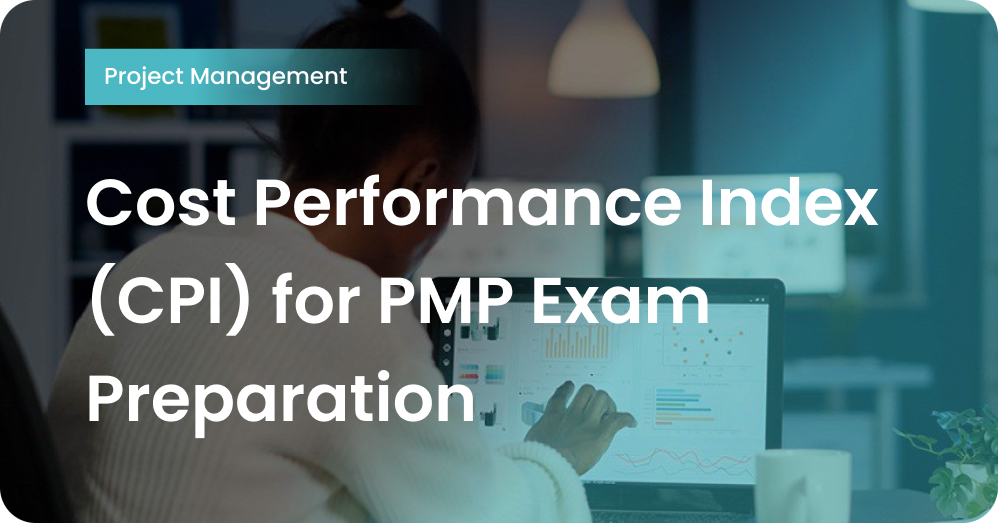Cost Performance Index (CPI) for PMP Exam Preparation
The Cost Performance Index (CPI) is a measure of planned resource cost efficiency represented as a ratio of earned value to actual cost. In layman's terms, the CPI measures how effectively the project adheres to its budget. A project manager must grasp the CPI formula and the formulae that constitute it in order to compute the CPI.
CPI Formula
The CPI formula for the PMP exam is evaluated by Earned Value (EV) and Actual Cost (AC). Each value has a formula, which will be embedded in PMP exam questions.
EV (Earned Value) = %Work Done * Budget
AC (Actual Cost) =Amount spent on Project
CPI = EV/AC
CPI Calculation
Calculating the Cost Performance Index gives insight into the project's budget health. The project manager will have a value of less than one (project over budget), 1 (project on a budget), or higher than one using the formula CPI = EV / AC (project under budget).
CPI in project management assesses a project's cost efficiency. Project Managers can utilize the CPI, with or without a PMP® certification, to present the entire story of the project's financial situation. The CPI might suggest that the initial budget was not matched with project results or that forecasts were overly cautious. The CPI is frequently used to forecast project costs for future years
CPI Examples
Example 1 - You have a project with Company B that has a 12-month deadline. The corporation has set aside $100,000 USD for this initiative. Six months have gone by, and 65,000 USD has been spent, but following closer scrutiny, you discover that only 45 percent of the work has been finished. Determine if you are under or over budget for this project by calculating the Cost Performance Index.
Solution - The actual cost (AC) is $65,000 USD.
Planned Value (PV) = 50% of $100,000 USD = 50,000 USD
Earned Value (EV) = 45% of $100,000 USD = 45,000 USD
CPI (Cost Performance Index) = EV / AC = 45,000 / 65,000
= 0.69
As a result, this project's Cost Performance Index (CPI) is 0.69.
Example 2 - A corporation is handed Project RED, which must be finished in 10 months and has a budget of 150,000 USD. This project has lasted 5 months and has cost 80,000 USD. Upon closer inspection, 70% of the work for this project has been accomplished.
Determine the Cost Performance Index for this project and if it is within or over budget.
Solution - The actual cost (AC) is $80,000 USD.
Planned Value (PV) = 50% of $150,000 USD = $75,000 USD
Earned Value (EV) = 70% of $150,000 USD
Cost Performance Index (CPI) = EV / AC = 105,000 USD = 105,000 / 80,000
= 1.31
As a result, this project's Cost Performance Index (CPI) is 1.31.
Schedule Performance Index (SPI
The Schedule Performance Index (SPI) compares your progress to the projected project schedule. The Schedule Performance Index (SPI) is a measure of schedule efficiency represented as the earned-to-planned value ratio. The Schedule Performance Index provides statistics on your project's time efficiency.
PMP Exam Preparation Cost Formulas
The PMP certification test may include or refer to 25 formulae, indicating the breadth of knowledge required by a project manager in any corporate scenario. The CPI and SPI formulae described here are components of Earned Value calculations.
- Project Specifications
- Workflow Diagram Structure
- Process of Change Management Integrated Project Plan
- Correct Timetable and Budget
- Budget and Timetable Contingency
- Cost Collection System
- Contingency Management
- Accurate Progress
- Management Support
Conclusion
SPI and CPI for projects should be determined by project managers. The formula is simple, and with correct quantities, it can be determined rapidly. The interpretation of the resulting value for both SPI and CPI is quite straightforward. To know what steps to take and how to use these schedule and cost insights to create modifications that lead to project success, a depth of project management expertise and understanding is required.
